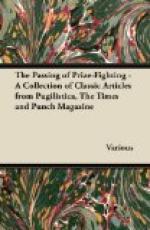* * * * *
“CLEAR THE GALLERIES.”
In response to the growth of dissatisfaction at the continued closing of certain picture galleries and museums, either wholly or in part, the Government has appointed a special commission to investigate the matter, under the presidency of Sir Tite Barnacle (fifth baronet). A report of the first session follows, during which the cases for the public and culture, and for the Government as against both, were fully stated.
The first witness was Lord HARCOURT, who said that he had done all he could, both in the House of Lords and in the columns of The Times, where, he was glad to say, large type was given him, to bring the Government to its senses on this matter. So long as the War was on, he and his fellow-critics had refrained from interfering. But now that it was over they demanded that the museums and galleries should be cleared at once of flappers and typewriters and thrown open again to their rightful users, the public.
Sir Buffer Stayte, K.C.B., O.B.E., speaking for his own Government department, said that, although in a manner of speaking the War was over, it was also not over. There was a heritage of trouble which required endless attention, and the best place to attend to it was in the museums and galleries. Experience had taught them that buildings filled with works of art acquired by the nation, either by purchase or gift, for the nation, and held as a national trust, were the most suitable places in which a clerical staff could perform clerical duties.
Lord HARCOURT begged to suggest that such a disregard of a national trust was a treachery.
Sir Buffer Stayte said that, although in ordinary times such might be the case, it was not so in war-time or while the Defence of the Realm Act was in force. Under Dora’s sanction all black was white. Personally he had every belief in the efficiency of the staffs now employed in the various public galleries and museums. He had seen them arrive late and leave early—he meant arrive early and leave late—and could not sufficiently admire their willingness to put up with the dismal surroundings of pictures and curiosities.
Mr. ROBERT WITT, one of the Trustees of the National Gallery, said that it was inconceivable to him as a business man that even if so many clerks should still be required there was not a more reasonable place for them than Trafalgar Square.
Sir Thomas Tannin, K.B.E., speaking for his own Government department, said that it was evident that Mr. WITT did not fully realise the position. These were historic and abnormal times and abnormal measures were necessary. We thought in high numbers, and therefore high numbers of clerks were needed. Trafalgar Square was as conveniently central a spot as could be found; hence their presence there. It had also been pointed out by the chiefs of the Government Clerks’ Tea Advisory Board that the




